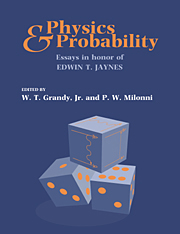Book contents
- Frontmatter
- Contents
- Preface
- Recollections of an Independent Thinker
- A Look Back: Early Applications of Maximum Entropy Estimation to Quantum Statistical Mechanics
- The Jaynes–Cummings Revival
- The Jaynes–Cummings Model and the One-Atom-Maser
- The Jaynes–Cummings Model is Alive and Well
- Self-Consistent Radiation Reaction in Quantum Optics – Jaynes' Influence and a New Example in Cavity QED
- Enhancing the Index of Refraction in a Nonabsorbing Medium: Phaseonium Versus a Mixture of Two-Level Atoms
- Ed Jaynes' Steak Dinner Problem II
- Source Theory of Vacuum Field Effects
- The Natural Line Shape
- An Operational Approach to Schrödinger's Cat
- The Classical Limit of an Atom
- Mutual Radiation Reaction in Spontaneous Emission
- A Model of Neutron Star Dynamics
- The Kinematic Origin of Complex Wave Functions
- On Radar Target Identification
- On the Difference in Means
- Bayesian Analysis, Model Selection and Prediction
- Bayesian Numerical Analysis
- Quantum Statistical Inference
- Application of the Maximum Entropy Principle to Nonlinear Systems Far from Equilibrium
- Nonequilibrium Statistical Mechanics
- A Backward Look to the Future
- Appendix: Vita and Bibliography of Edwin T. Jaynes
- Index
The Jaynes–Cummings Model is Alive and Well
Published online by Cambridge University Press: 21 October 2009
- Frontmatter
- Contents
- Preface
- Recollections of an Independent Thinker
- A Look Back: Early Applications of Maximum Entropy Estimation to Quantum Statistical Mechanics
- The Jaynes–Cummings Revival
- The Jaynes–Cummings Model and the One-Atom-Maser
- The Jaynes–Cummings Model is Alive and Well
- Self-Consistent Radiation Reaction in Quantum Optics – Jaynes' Influence and a New Example in Cavity QED
- Enhancing the Index of Refraction in a Nonabsorbing Medium: Phaseonium Versus a Mixture of Two-Level Atoms
- Ed Jaynes' Steak Dinner Problem II
- Source Theory of Vacuum Field Effects
- The Natural Line Shape
- An Operational Approach to Schrödinger's Cat
- The Classical Limit of an Atom
- Mutual Radiation Reaction in Spontaneous Emission
- A Model of Neutron Star Dynamics
- The Kinematic Origin of Complex Wave Functions
- On Radar Target Identification
- On the Difference in Means
- Bayesian Analysis, Model Selection and Prediction
- Bayesian Numerical Analysis
- Quantum Statistical Inference
- Application of the Maximum Entropy Principle to Nonlinear Systems Far from Equilibrium
- Nonequilibrium Statistical Mechanics
- A Backward Look to the Future
- Appendix: Vita and Bibliography of Edwin T. Jaynes
- Index
Summary
Introduction
In 1963, E. T. Jaynes and F. W. Cummings published a paper entitled “Comparison of Quantum and Semiclassical Radiation Theories, with Application to the Beam Maser.” This paper was written at a time when the quantum theory of the laser had not yet been worked out, and represented an attempt at discussing the new behaviour that could be expected from treating the field quantum mechanically instead of classically. Jaynes and Cummings began by considering the interaction between a single two-level molecule and a single field mode, a simple situation which has become known as the Jaynes-Cummings model. Treating then the maser medium as a beam of two-level systems initially in a mixture of their upper and lower states characterized by a temperature T, they found that the field mode reached a thermal equilibrium with temperature Tf = ΩT/ω, where ω is the transition frequency of the two-level systems and Ω is the field mode frequency, provided that T > 0. For T < 0, the steady state field was found to contain an infinite amount of energy, an unphysical result resulting from the neglect of losses in the model. Jaynes and Cummings then proceeded to develop an alternative semi-classical theory of the beam maser, introducing their famous neo-classical theory of spontaneous emission.
An important follow-up paper was published by F. W. Cummings, who studied the long-time behavior of a two-level system interacting with a quantized single-mode field initially in a coherent state.
Information
- Type
- Chapter
- Information
- Physics and ProbabilityEssays in Honor of Edwin T. Jaynes, pp. 49 - 62Publisher: Cambridge University PressPrint publication year: 1993
